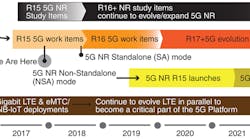Differentiate Between 4G LTE and Non-Standalone 5G NR Antennas (.PDF Download)
In December 2017, the Third Generation Partnership Project (3GPP) issued Release 15, which created an early version of 5G, called 5G non-standalone (NSA). NSA 5G New Radio (NR) implements some of the key 5G application features, namely enhanced mobile broadband (eMBB) and ultra-reliable low-latency communications (URLLC), as well as detailing new sub-6-GHz frequencies and introducing millimeter-wave (mmWave) frequency bands.
Some of the methods enabling new NSA 5G NR specifications have been available in 4G LTE Advanced Pro, namely multiple-input, multiple-output (MIMO) and carrier aggregation (CA). However, Release 15 defines advanced versions of these technologies alongside the need for co-location and compatibility between 4G and 5G RF hardware.
The migration and incorporation of 4G LTE frequency bands, new technologies, new frequencies, and new methods of deployment are significantly changing NSA 5G NR antenna requirements in comparison to 4G LTE antennas. This article aims to describe how the new specifications of NSA 5G NR lead to design, performance, and infrastructure changes in the implementation of next-generation antennas for base stations and user equipment (UE).
Introduction
As stated, the key features of 3GPP Release 15 NSA 5G NR are eMBB and URLLC.1 These features are enabled by advanced antenna techniques, antenna tuning, and infrastructure changes regarding deployment of base stations and UEs. These changes directly impact antenna design and technologies, creating a rift between previous 4G LTE antennas and future 5G versions. Beyond opening up additional sub-6-GHz spectrum and assigning new mmWave spectrum for NSA 5G NR, many other operational dynamics exist that define the differences between 4G LTE and NSA 5G NR antennas (Fig. 1).
1. The 3GPP Release timeline for 5G coincides with developments of LTE, which will eventually merge, posing interim challenges for hardware manufacturers designing antennas to serve multiple specifications.










